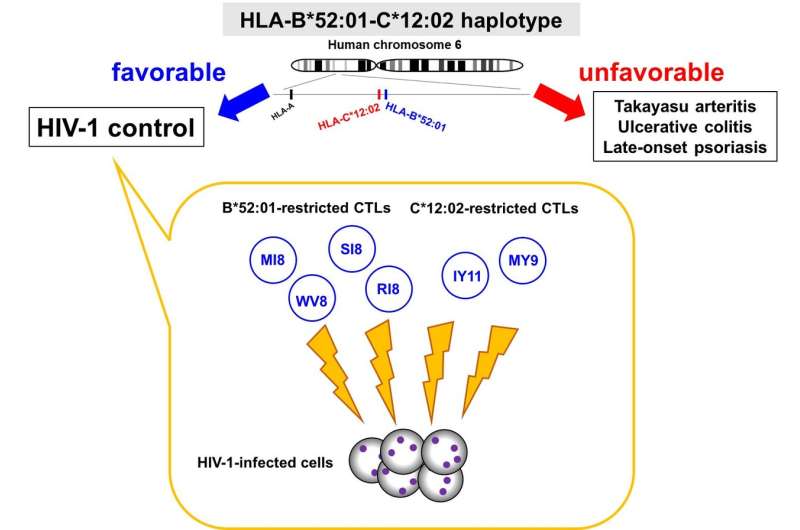The HLA-B*52:01 and -C*12:02-restricted CTLs strongly suppress HIV-1 replication resulting in slower disease progression. In contrast, the HLA-B*52:01-C*12:02 haplotypes are susceptible to autoimmune diseases. Credit: Professor Masafumi Takiguchi
Twenty percent of the Japanese population have a group of genes inherited from a single parent (haplotype) that, while connected to ulcerative colitis and Takayasu arteritis, is known to be protective against HIV-1.
Researchers from the Center for AIDS Research at Kumamoto University previously found that HLA-B*52:01 and -C*12:02 haplotypes associate with lower plasma viral loads (pVL) and higher CD4 counts than patients with neither haplotype and that HLA-B*52:01 can suppress HIV-1 replication by producing HIV-1-specific cytotoxic T lymphocytes (CTLs). However, direct evidence of HLA-C alleles and their related CTLs controlling HIV-1 have remained obscured until now.
In a previous study of natural killer (NK) cells, the Kumamoto researchers found that HIV-1 infected patients with a combination of HLA-C*12:02 and KIR2LD2 (a receptor for HLA-C*12:02) had a lower pVL than patients with just one or neither of those immunological constituents. They indicated that, like HLA-B, the HLA-C group also plays a part in regulating HIV-1. However, due to the strong linkage between the two alleles, distinguishing which of the two effects the HIV-1 virus has been difficult to determine.
To overcome this problem, the researchers searched for particular parts (T cell epitopes) of antigens to determine which produced the strongest immune response to the HLA-C*12:02 haplotype. In a population of HIV-1 infected Japanese HLA-C*12:02 carriers, they were able to identify Nef MY9 and Pol IY11 as immunodominant epitopes, thereby showing that HLA-C supplements HLA-B's control of HIV-1 in infected individuals.
"Unfortunately, this haplotype is associated with several other diseases in the Japanese population," said Professor Masafumi Takiguchi, leader of the research project. "Though they can evidently control HIV-1, they may also cause other autoimmune diseases or even allergies when the immune response is too strong. Even so, this study adds a piece to the AIDS research knowledge puzzle."
More information: Takayuki Chikata et al, Control of HIV-1 by an HLA-B*52:01-C*12:02 Protective Haplotype, The Journal of Infectious Diseases (2017). DOI: 10.1093/infdis/jix483
Journal information: Journal of Infectious Diseases
Provided by Kumamoto University






















